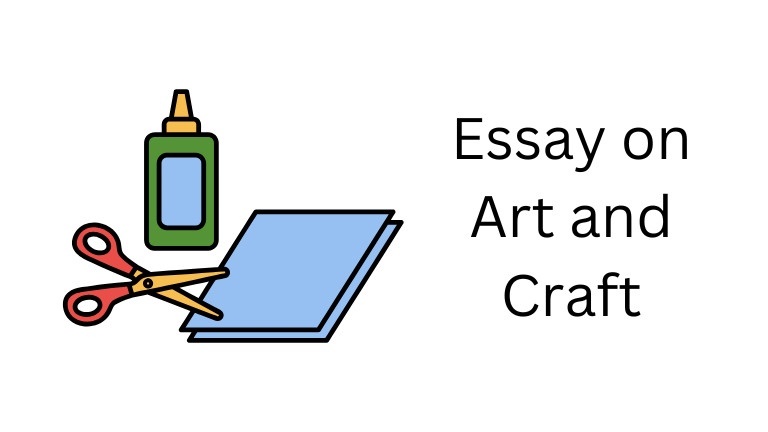Essay on Art and craft are powerful modes of human expression, celebrating creativity and skill in unique ways. While art often conveys emotion and personal vision, craft highlights the mastery of technique and practicality. Both have played an integral role in shaping cultures, economies, and personal identities across the globe.
What is Art?
Art is a form of expression that captures the imagination and emotion of the creator. It encompasses a wide range of mediums, including:
- Visual Arts: Painting, drawing, and sculpture.
- Performing Arts: Dance, music, and theater.
- Digital Arts: Graphic design and animation.
Art focuses on aesthetics and emotional resonance, often leaving interpretations open to the observer.
What is Craft?
Craft refers to the creation of functional or decorative objects using skilled techniques. Examples include pottery, knitting, weaving, and wood carving. Unlike art, craft is typically rooted in tradition and practicality, emphasizing the utility of the finished product alongside its beauty.
Differences Between Art and Craft
| Aspect | Art | Craft |
|---|---|---|
| Purpose | Expression and emotion | Utility and functionality |
| Skill | Requires creativity and imagination | Focused on precision and technique |
| Examples | Painting, sculpture | Pottery, embroidery |
| Interpretation | Open to multiple meanings | Defined by craftsmanship |
Despite their differences, art and craft often overlap, creating a harmonious blend of beauty and functionality.
The Role of Creativity
Creativity is the cornerstone of both art and craft. Artists and artisans rely on their imagination to produce works that resonate with audiences or serve a purpose. Whether designing a sculpture or weaving a basket, creativity drives innovation and individuality.
Cultural Significance
Art and craft are deeply embedded in cultural traditions and heritage. From the intricate patterns of Indian Madhubani paintings to the woven textiles of South America, these creations tell stories of history, identity, and societal values. Essay on Art and Craft serve as a bridge connecting generations and preserving traditions.
Art and Craft in Education
Introducing art and craft in education nurtures cognitive and emotional growth. Benefits include:
- Motor Skills: Activities like drawing and crafting enhance hand-eye coordination.
- Critical Thinking: Encourages problem-solving and innovative thinking.
- Emotional Development: Provides a medium for self-expression and stress relief.
Art and craft programs also foster teamwork and communication skills, enriching overall education.
Tools and Techniques
The tools and techniques used in art and craft vary widely:
- Art Tools: Brushes, canvases, and digital software.
- Craft Tools: Looms, needles, and carving tools.
Mastery of these tools is essential for creators to translate their vision into reality.
Modern Innovations in Art and Craft
The integration of technology has revolutionized both fields:
- Digital Art: Tools like Photoshop and Procreate have expanded artistic possibilities.
- 3D Printing: Allows artisans to create intricate designs with precision.
- Online Platforms: Enable global sharing and selling of art and craft.
These innovations have democratized creativity, making it accessible to wider audiences.
Therapeutic Benefits
Art and craft have therapeutic applications that promote mental health and well-being:
- Art Therapy: Helps individuals process emotions and reduce stress.
- Crafting: Activities like knitting and pottery provide a calming and meditative experience.
These practices are increasingly used in rehabilitation programs and mental health treatments.
Economic Importance
Art and craft contribute significantly to the global economy:
- Craft Industries: Provide employment in rural and urban areas.
- Art Markets: Generate revenue through galleries, auctions, and commissions.
- Tourism: Cultural crafts attract tourists, boosting local economies.
Supporting art and craft industries preserves traditions while fostering economic growth.
Global Influence
Globalization has expanded the reach of traditional art and craft. While this has brought recognition to many artisans, it has also posed challenges like cultural appropriation and mass production. Balancing global influence with local authenticity is essential.
Art and Craft as Professions
Careers in art and craft are diverse, ranging from fine artists to product designers and artisans. Professional opportunities include:
- Artists: Painters, sculptors, and digital designers.
- Craftspeople: Potters, weavers, and jewelry makers.
- Educators: Teaching art and craft in schools or workshops.
Each profession requires dedication, creativity, and continuous learning.
Essay on Art and Craft: Challenges in the Field
Despite their importance, art and craft face challenges:
- Commercialization: Mass production often devalues handmade crafts.
- Undervaluation: Artists and artisans struggle to receive fair compensation.
- Sustainability: Craft materials can have environmental impacts.
Addressing these issues requires public awareness and government support.
The Future of Art and Craft
The future of art and craft lies in innovation and sustainability. Eco-friendly materials, digital platforms, and renewed interest in traditional forms can ensure their continued relevance. As society evolves, so will the ways in which art and craft inspire and connect people.
Conclusion
Art and craft are timeless expressions of human creativity and skill. They enrich lives, preserve culture, and contribute to economies worldwide. By valuing and supporting these fields, we honor the ingenuity of past generations and pave the way for future creators.
Essay on Art and Craft: FAQs
- What is the difference between art and craft?
Art emphasizes expression and emotion, while craft focuses on functionality and technique. - How does crafting benefit mental health?
Crafting provides a calming, meditative experience that reduces stress and promotes mindfulness. - Why is art important in education?
Art fosters creativity, critical thinking, and emotional development in students. - What are some examples of crafts?
Pottery, knitting, wood carving, and jewelry making are popular examples. - How has technology impacted art and craft?
Tools like digital software and 3D printing have expanded creative possibilities in both fields. - What challenges do artisans face today?
Issues include commercialization, undervaluation of handmade work, and environmental sustainability.
